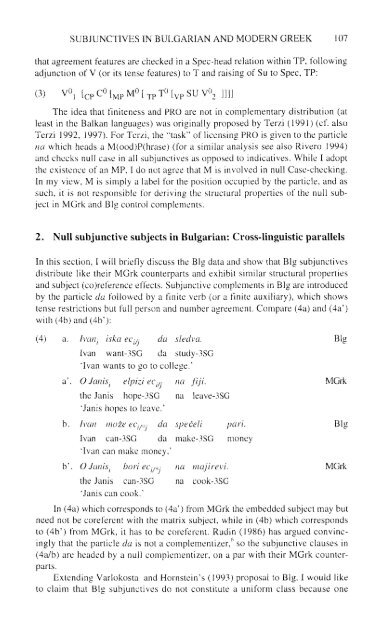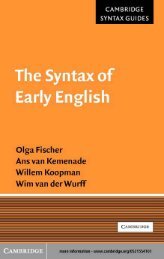Comparative Syntax of the Balkan Languages (Oxford ... - Cryptm.org
Comparative Syntax of the Balkan Languages (Oxford ... - Cryptm.org
Comparative Syntax of the Balkan Languages (Oxford ... - Cryptm.org
- No tags were found...
You also want an ePaper? Increase the reach of your titles
YUMPU automatically turns print PDFs into web optimized ePapers that Google loves.
SUBJUNCTIVES IN BULGARIAN AND MODERN GREEK 107that agreement features are checked in a Spec-head relation within TP, followingadjunction <strong>of</strong> V (or its tense features) to T and raising <strong>of</strong> Su to Spec, TP:(3) V°, [ CP C° [ Mp M° [ TP T () [ vp SU V° 2 ]]]]The idea that finiteness and PRO are not in complementary distribution (atleast in <strong>the</strong> <strong>Balkan</strong> languages) was originally proposed by Terzi (1991) (cf. alsoTerzi 1992, 1997). For Terzi, <strong>the</strong> "task" <strong>of</strong> licensing PRO is given to <strong>the</strong> particlena which heads a M(ood)P(hrase) (for a similar analysis see also Rivero 1994)and checks null case in all subjunctives as opposed to indicatives. While I adopt<strong>the</strong> existence <strong>of</strong> an MP, I do not agree that M is involved in null Case-checking.In my view, M is simply a label for <strong>the</strong> position occupied by <strong>the</strong> particle, and assuch, it is not responsible for deriving <strong>the</strong> structural properties <strong>of</strong> <strong>the</strong> null subjectin MGrk and Blg control complements.2. Null subjunctive subjects in Bulgarian: Cross-linguistic parallelsIn this section, I will briefly discuss <strong>the</strong> Blg data and show that Blg subjunctivesdistribute like <strong>the</strong>ir MGrk counterparts and exhibit similar structural propertiesand subject (co)reference effects. Subjunctive complements in Blg are introducedby <strong>the</strong> particle da followed by a finite verb (or a finite auxiliary), which showstense restrictions but full person and number agreement. Compare (4a) and (4a')with (4b) and (4b'):(4) a. Ivani iska ec^/. da sledva. BlgIvan want-3SG da study-3SG"Ivan wants to go to college.'a'. O Janis • elpi~i ec (/ na fiji. MGrk<strong>the</strong> Janis hope-3SG na leave-3SG'Janis hopes to leave.'b. Ivan inoze ec i/i:j da speceli pari. BlgIvan can-3SG da make-3SG money'Ivan can make money,'b'. O Janis ( boriccy*-. na majirevi. MGrk<strong>the</strong> Janis can-3SG na cook-3SG'Janis can cook.'In (4a) which corresponds to (4a') from MGrk <strong>the</strong> embedded subject may butneed not be coreferent with <strong>the</strong> matrix subject, while in (4b) which correspondsto (4b') from MGrk, it has to be coreferent. Rudin (1986) has argued convincinglythat <strong>the</strong> particle da is not a complementizer,' so <strong>the</strong> subjunctive clauses in(4a/b) are headed by a null complementizer, on a par with <strong>the</strong>ir MGrk counterparts.Extending Varlokosta and Hornstein's (1993) proposal to Blg, I would liketo claim that Blg subjunctives do not constitute a uniform class because one
















